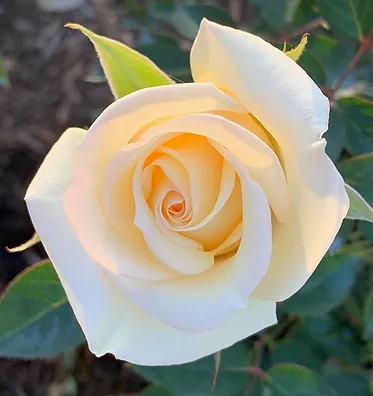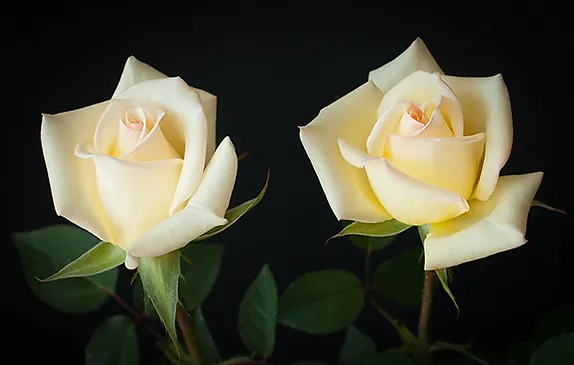by Bob Martin, ARS President 2018-2021
BELOW: ‘Butter Cream’, photo by Bob Martin

Challenged by our Editor to select one rose to write about, I decided at once to pick the best of my own creations – ‘Butter Cream’.
A rose “hybridizer” is one who is responsible for the discovery or creation of a new rose. And since there is nothing about roses that does not interest me, there came a time circa 1992 when my thoughts about roses had turned to becoming a hybridizer.
My first step was to seek some information on the subject. I had heard of the Rose Hybridizers Association (www.rosebreeders.org), which has continued to this day as an important organization for advancing the interests of amateur hybridizers. Of particular interest I learned that the Rose Hybridizers Association publishes an excellent handbook titled “Rose Hybridizing for Beginners”. So I ordered it and read it cover to cover and then again.
Following some earlier introductions dating to 1995, my best-known rose, introduced in 2003 is the miniflora ‘Butter Cream’, a cross of ‘Anne Morrow Lindbergh’ x ‘Fairhope’.

In selecting its parents, I was guided by a horse breeding principle I had learned in my law practice that says, “Breed the best to the best and hope for the best”. Following that principle, I selected ‘Anne Morrow Lindbergh’ because it was the seed parent of the top-rated exhibition hybrid tea, ‘Gemini’. And, I selected the miniature rose ‘Fairhope’ because it was then the top-rated miniature exhibition rose in the country, a position that it went on to hold for eleven consecutive years through 2006. (LEFT: ‘Butter Cream’ matched pair, photo by Dona Martin).
‘Butter Cream’ has many similarities to ‘Fairhope’, however the blooms are a clean medium butter yellow and much larger (about 2-inches), marking it a true miniflora. The classic form is extraordinary and more high-centered than ‘Fairhope’, a trait it appears to have taken from its seed parent, ‘Anne Morrow Lindbergh’. The blooms typically have about 28-32 petals. The yellow is more prominent in cooler, overcast weather and shaded conditions; in hot sunny conditions the blooms tend to be whiter. The blooms appear one to a stem and have excellent substance, lasting a long time on the bush and as a cut flower.
The bush itself is upright, tall (30-inches), with medium green, semi-glossy, highly disease-resistant foliage. It is very vigorous and grows well on its own roots, producing show-quality blooms at an early age. The exceptional quality of the bush, and particularly its disease resistance, has lead Ping Lim to use in his breeding program that focuses on disease resistant varieties.
‘Butter Cream’ was, however, bred primarily to be a show contender and has not disappointed. In its first appearance on the show tables, it won the seedling class at the San Jose Spring National in April 2002. Following its commercial introduction by Rosemania in 2003 it recorded its first Queen at the Gainesville Rose Society show in Florida on April 26, 2003, shown by Steve Felts of Ocala, Florida. This was also the first Queen of Show for him and came with the second bloom on a plant he had received in March.
Since its introduction, ‘Butter Cream’ has been a top ranked exhibition miniflora, including several years as #1. Through the end of the 2019 season, ‘Butter Cream’ as an individual bloom has recorded 121 Queens nationally, in addition to more than 600 appearances as royalty or in major challenge classes. It has also demonstrated an ability to produce show-quality sprays, ranking in the top ten in that category for several years.
Much of the show success of ‘Butter Cream’ is attributable to my dear friend Suzanne Horn who claims ‘Butter Cream’ as her favorite rose as well. Suzanne has known ‘Butter Cream’ since its earliest days, having seen it as a seedling in my garden. In fact, we discussed an appropriate name for it on several occasions; my recollection being that she had preferred ‘Crème Brulee’.
Suzanne’s success with showing ‘Butter Cream’ has been amazing and I freely admit she shows the rose better than anyone I know, including I will add my great friend Dr. Satish Prabhu who has told me he considers ‘Butter Cream’ the best miniflora ever introduced. In fact, Suzanne has been winning trophies with it since the year of its introduction in 2003 and has won 91 trophies since.
Suzanne won her first two Queens with ‘Butter Cream’ in October of 2004, and since that time has won a total of six Queens of Show. She has also utilized it in many different classes, including challenge collection, miniflora English box, miniflora vase of three, miniflora vase of six, miniflora vase of twelve, miniflora cycle of bloom, miniflora artist’s palette, miniflora picture frame and miniflora rose in bowl. One of the best is a stunning miniflora basket pictured in an accompanying article by Suzanne.
‘Anne Morrow Lindbergh’ has continued as the mother of many of the roses I have bred. A pink, white and yellow blend hybrid tea, ‘Anne Morrow Lindbergh’ in our garden is a huge upright bush on ‘Fortuniana’ rootstock with dozens of canes producing an abundance of classic high centered formed blooms with beautiful iridescent seashell color. For show purposes, the petals are very tender and are difficult to groom without splitting. It also does not refrigerate well and requires near perfect timing to get it to the show table.
The strength, however, of ‘Anne Morrow Lindbergh’ is as a mother. As noted, it is the mother of ‘Gemini’. It was also used as a seed parent in the production of the hybrid teas, ‘Vanilla Perfume’ and ‘Diana, Princess of Wales”, the namesake of the mother of the future king of England.
‘Anne Morrow Lindbergh’ as a seed parent produces large abundant hips, each of which contain large seeds that are relatively easy to handle. As a seed parent, it takes pollen easily and the seeds have a high rate of germination. But best of all, it produces multiple outstanding offspring of various colors.
One of my earliest crosses was of ‘Anne Morrow Lindberg’ x ‘Glowing Amber’ which produced my white floribunda, ‘Pasadena Star’. After the sister seedlings ‘Butter Cream’ and ‘Peter Cottontail’, I made a later cross with my rose ‘Bolivar’ to produce the floribunda, ‘Peachy Cheeks’. Subsequent crosses with the floribunda ‘Julia Child’ have produced an abundance of offspring, including the floribunda, ‘Escondido Sunset’; the shrub, ‘Ruth Tiffany’; and the minifloras, ‘Angel Grace’, ‘Bronze Medal’ and ‘Coconut Shrimp’.
The breeding of ‘Anne Morrow Lindbergh’ itself is something of a mystery. The 1993 patent application discloses that it was bred by the late William A. Warriner, from a cross of two unnamed seedling varieties known only as “78-5563” x “75-3762”. It was originally introduced in 1993 in Australia and named ‘Melinda Gainsford’, after a well-known Australian athlete. Some clue as to the parentage of those varieties is suggested by the roses selected as “comparators” in a comparative trial conducted in Australia from October 1993 – April 1994. There the comparators were ‘Pristine’ and ‘Princess De Monaco’, either or both of which could plausibly have played a role in the genealogy of ‘Anne Morrow Lindbergh’.
To complete the story, I also had a hand in the naming of ‘Anne Morrow Lindbergh’. In 1993, while then with the Pasadena Rose Society I was approached by one of our members who was a publicist for the then 87-year old Anne Morrow Lindbergh. She told me that Anne Morrow Lindbergh loved roses and was willing to lend her name to a suitable rose, notwithstanding that she had never previously permitted her name to be used as an endorsement of any product. At my suggestion she contacted Jackson & Perkins Co who, liking the idea, presented photos of three ready-to-introduce roses for consideration. I selected the one with the seashell-like colors as being the most appropriate and Jackson & Perkins Co. introduced it into the United States in 1994 as ‘Anne Morrow Lindbergh’. As a reward, I received a bush of the newly named variety, which I later used to produce ‘Butter Cream’.
One of the great excitements about rose hybridizing is the daily walk among seedlings in germination, greeting new flowers with anticipation. Most lack novelty or have other issues that weigh against their successful commercial introduction. But, each is unique and a reminder of God’s work. My cross of Anne Morrow Lindbergh’ x ‘Fairhope’ in 2000 produced 30 seedlings in 2001. The #4 seedling, designated 01-AnnFair-04, was later introduced as ‘Peter Cottontail’, the #7 seedling, designated 01-AnnFair-07, was ‘Butter Cream’. The other 28 were discarded. My initial notes on ‘Butter Cream’ said “White with classic form”. As it developed it was more yellow and was eventually released as a light yellow. I actually remember the first bloom because it was extraordinary and I knew at once that if I could get a plant under it, I would have something. As it turns out, getting a good plant from an ‘Anne Morrow Lindbergh’ cross is the norm.
To conclude, I and am reminded of the Scriptural passage, “Consider the lilies of the field, how they grow; they toil not, neither do they spin: And yet I say unto you that even Solomon in all his glory was not arrayed like one of these.” (Matthew 6:28-29) The Rose – and especially my rose, ‘Butter Cream’ – is to me a gift from our Creator, one superior even to the lilies of the field.




























































